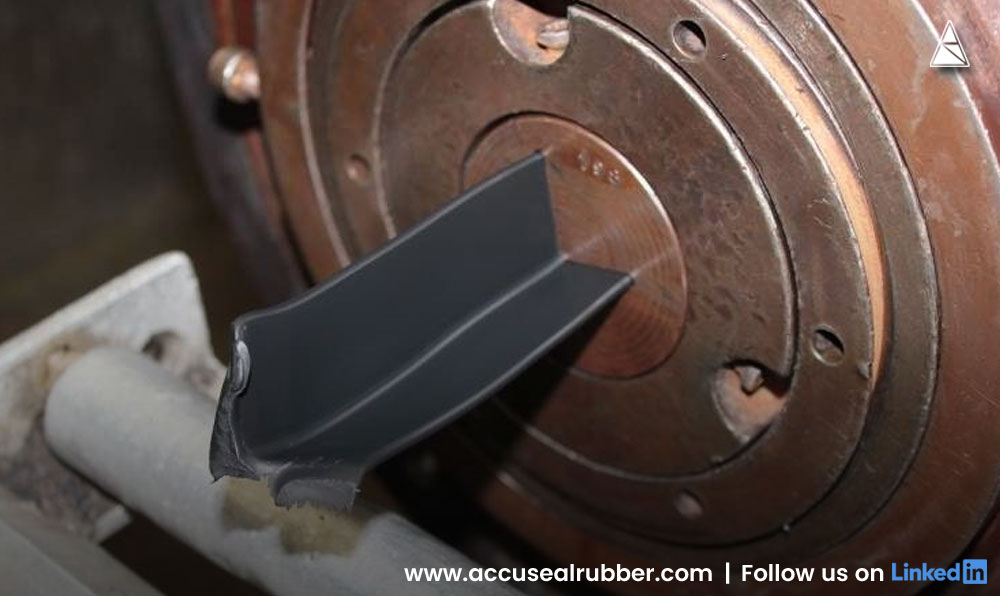Rubber products play a crucial role across various industries, from automotive to construction, healthcare to electronics. Two primary manufacturing processes—molding and extrusion—are commonly used to create rubber components, each with its distinct advantages and applications. Understanding the differences between molded and extruded rubber products can help businesses choose the right manufacturing method based on their specific requirements.
In this blog, we’ll explore the key differences between these two processes, their applications, and the benefits they offer.
What is Molded Rubber?
Molded rubber products are created by placing rubber material into a mold and subjecting it to heat and pressure. This process allows the rubber to take the shape of the mold, producing a finished component with precise dimensions and intricate details.
There are three main types of molding used in rubber manufacturing:
Compression Molding: This involves placing a pre-measured amount of rubber into a heated mold. When the mold is closed, heat and pressure force the rubber to fill the mold cavities and take shape.
Transfer Molding: In this process, rubber is heated in a chamber and then transferred into the mold using a plunger. This method is often used for parts with more complex geometries or when embedded components (like metal inserts) are needed.
Injection Molding: Rubber is heated and injected into a mold under pressure, allowing for faster production and more consistent part quality. This process is highly automated and is suitable for high-volume production runs.
Applications of Molded Rubber Products
Molded rubber products are ideal for applications that require complex shapes, tight tolerances, or specific performance characteristics. Examples of molded rubber products include:
- Seals and gaskets: Molded rubber gaskets provide tight seals in automotive, plumbing, and industrial applications.
- O-rings: Used in a wide range of industries for sealing.
- Custom rubber parts: Molded rubber is frequently used for creating custom shapes, such as vibration isolation mounts, bushings, and pads.
Advantages of Molded Rubber Products
- Precision: The molding process allows for intricate shapes and designs, making it ideal for components with tight tolerances.
- Versatility: Molded rubber products can be designed to include inserts, metal components, or other materials, creating multi-material products.
- Durability: Molded rubber components can be designed to withstand harsh environments, extreme temperatures, and chemical exposure.
What is Extruded Rubber?
Extrusion is a continuous manufacturing process where rubber material is forced through a shaped die to create long lengths of consistent cross-sectional profiles. Unlike molding, which produces parts in individual molds, extrusion allows for the creation of continuous products.
The process involves heating rubber material and forcing it through an extruder, which shapes the material into the desired profile. The rubber is then cured, either by vulcanization or using other curing methods, to achieve its final form.
Applications of Extruded Rubber Products
Extruded rubber products are typically used in applications that require long lengths of rubber with uniform cross-sections. Common examples include:
- Rubber tubing and hoses: Used in medical, automotive, and industrial applications for fluid transport.
- Weatherstripping: Extruded rubber weatherstrips are commonly used in doors and windows to seal against air and water infiltration.
- Seals and gaskets: Continuous extruded rubber seals are used in automotive and construction applications to provide flexible sealing solutions.
Advantages of Extruded Rubber Products
- Cost-Effectiveness: Extrusion is an efficient process for producing large quantities of rubber products with consistent cross-sections.
- Continuous Production: The extrusion process allows for the creation of long lengths of rubber, making it ideal for products like tubing, weatherstripping, and seals.
- Custom Profiles: Extruded rubber can be produced in custom shapes and profiles to meet the specific needs of an application.
Key Differences Between Molded and Extruded Rubber Products
Manufacturing Process
- Molded Rubber: Uses a mold to shape individual parts. Suitable for producing complex shapes with tight tolerances.
- Extruded Rubber: Involves forcing rubber through a die to create continuous products. Best for creating long lengths of uniform profiles.
Applications
- Molded Rubber: Ideal for products requiring intricate details, such as O-rings, seals, and gaskets.
- Extruded Rubber: Suited for continuous products like rubber tubing, weatherstripping, and gaskets with consistent cross-sections.
Production Volume
- Molded Rubber: Generally used for smaller production runs or custom components, though it can also be automated for high-volume production.
- Extruded Rubber: Typically used for high-volume production, especially when long continuous lengths of material are needed.
Precision and Complexity
- Molded Rubber: Allows for more complex geometries and precise tolerances, making it ideal for parts with intricate designs.
- Extruded Rubber: Best for simple, uniform shapes that can be produced continuously without intricate details.
Cost
- Molded Rubber: Costs can be higher for molded products due to the complexity of the molds and the precision required. However, it is more cost-effective for complex parts.
- Extruded Rubber: Generally more cost-efficient for producing continuous profiles and long runs, particularly for simple shapes.
Choosing the Right Process for Your Application
The choice between molded and extruded rubber products depends on your specific application requirements. If you need complex, high-precision components with tight tolerances, molded rubber is the better choice. However, for continuous profiles like tubing, seals, or weatherstripping, extruded rubber offers cost-effective and efficient production.
At Accuseal Rubber Inc., we specialize in both molded and extruded rubber products, ensuring that we can meet the needs of diverse industries. Our team of experts can help you choose the right process and rubber material based on your application’s unique specifications.
Understanding the differences between molded and extruded rubber products is essential for choosing the best manufacturing method for your application. Molded rubber offers precision and complexity, making it ideal for intricate parts, while extruded rubber is perfect for producing continuous profiles with consistent cross-sections.
Whether you need custom-molded components or continuous extruded products, Accuseal Rubber Inc. is your trusted partner. Contact us today to discuss your project and find the best rubber solution for your needs.

 Nick Parker
Nick Parker